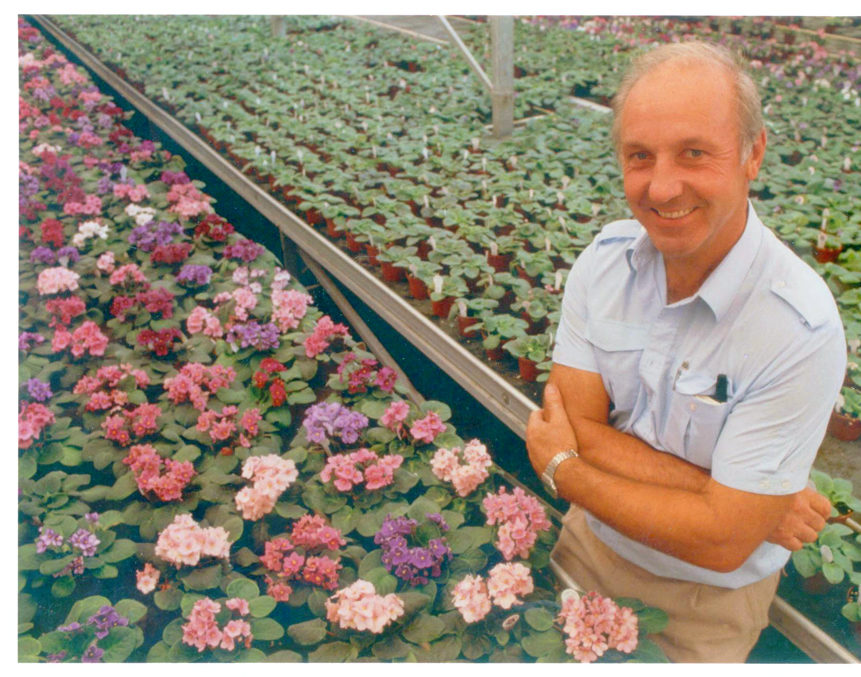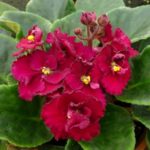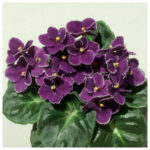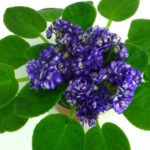
I love African violets! What’s not to love? They are compact, pack a huge punch with their beautiful, delicate flowers, and they bloom almost continuously, which should earn them the title of belle of the houseplant ball.
I got bit by the African violet bug many years ago when I worked for the NBC-TV affiliate in Nashville, Tennessee. I did a story on African violets which included an interview with Reinhold Holtkamp, Sr., founder of Optimara Violets, the world’s largest producer of African violets.
I was too young at the time, more than 40 years ago, to be intimidated by this giant in the floral industry and I know that now I would probably ask different questions for a more knowledgeable perspective. But maybe it was for the best because I probably asked the kind of questions that anyone would ask which makes for a better interview.
 I will never forget walking in to one of the many giant greenhouses at Holtkamp Nurseries. It was a sea of color from the thousands of African violets in bloom, as far as the eye could see. It took my breath away! Even though I’m quite sure Mr. Holtkamp had more important things to accomplish that day, he gave this young reporter his undivided attention and shared his knowledge with me as if he had all the time in the world. After all these years, it is a memory that has stayed with me and I remember the experience as if it were yesterday.
I will never forget walking in to one of the many giant greenhouses at Holtkamp Nurseries. It was a sea of color from the thousands of African violets in bloom, as far as the eye could see. It took my breath away! Even though I’m quite sure Mr. Holtkamp had more important things to accomplish that day, he gave this young reporter his undivided attention and shared his knowledge with me as if he had all the time in the world. After all these years, it is a memory that has stayed with me and I remember the experience as if it were yesterday.
A passion for growing African violets launched the nursery starting with his grandfather in 1904. Reinhold Holtkamp, Sr. was the 3rd generation in the family business, when in 1977 he decided to expand their international operation to America, locating their greenhouses to Nashville, Tennessee. The company has grown to be the world’s largest producer of African violets, supplying the entire North American market with their Optimara African violet. Mr. Holtkamp passed away in 2012 but the family impact on the production of African violets will live on through his children and grandchildren who are active in the business today. Here is an excerpt from his obituary that gives you an idea of his legacy:
Mr. Holtkamp served as President and Director of Research and Development of the Optimara Group for over 30 years. His research, effort, and love for the African Violet had no limits. When working with NASA in 1984, some of his African Violet seeds were sent into space encouraging mutations due to weightlessness & cosmic rays that would bring new characteristics to the African Violet world. His vision was to make the African Violet more colorful and easier to care for.

And that they have. Before 1965, African violets couldn’t be shipped because the flowers dropped off so easily. Holtkamp Nurseries bred a stronger “nondropping” variety, a trait that’s standard now. Today, they offer about 500 violet varieties — in dozens of colors, blanketing 500,000 square feet of greenhouse space — with 1,500 new varieties in research and development.
The colors are dazzling and available in single, double, bi-color, and some with variegated and ruffled leaves. There are even miniature varieties that come with a wick watering system. Optimara violets are carried by Home Depot, Lowe’s and grocery store chains including Kroger and Publix. So finding these beauties is easy.
It’s amazing that something so beautiful is so easy to grow. The basic guidelines for African violet care are simple:
Soil – Pot the plant into the right soil. Special mixes are available or make your own from peat moss, vermiculite, and perlite in equal parts. I usually leave mine in the same plastic pot in which they came.
Water – Water with lukewarm or tepid water. Water at the base and never splash the foliage with water; just a drop can cause foliar spots and damage. Water when the soil feels less moist to the touch. Never let growing African violets stand in water. Wick watering, from the bottom, is sometimes appropriate or you can put them on a tray or drip plate filled with small pebbles and put the water in the tray. The roots will absorb the amount of water they need.
Light – African violets do best in bright, indirect light. Avoid direct sunlight. Plants with dark green foliage usually need somewhat higher light levels than those with pale or medium green foliage.
Fertilizer – Fertilize African violet plants with special African violet food or a food with a higher phosphorus number — the middle number in the NPK fertilizer ratio, as 15-30-15. Fertilizer can be mixed at one-quarter strength and used at every watering. Reduced flowering and paler leaf color indicate that growing African violets are not getting enough fertilizer.
Pinch blooms from the growing African violets when they are spent. This will encourage the development of more flowers.
I will let you in on a tip that Mr. Holtkamp shared with me about getting your violet to rebloom. He said, “Neglect them for a bit. Let them dry out just to the point that the leaves begin to droop a little, then give them a dose of fertilizer.” It works. I’ve used that advice many times over the years.
We all need a little dose of happiness and color, especially during the gray days of winter. Grow an African violet and put on a happy face!







